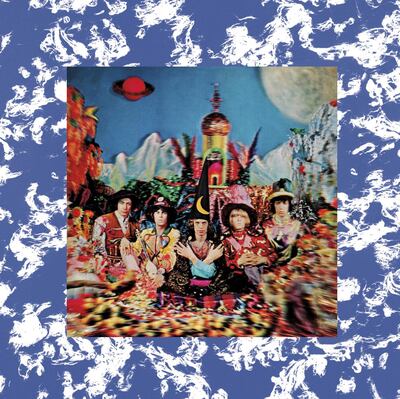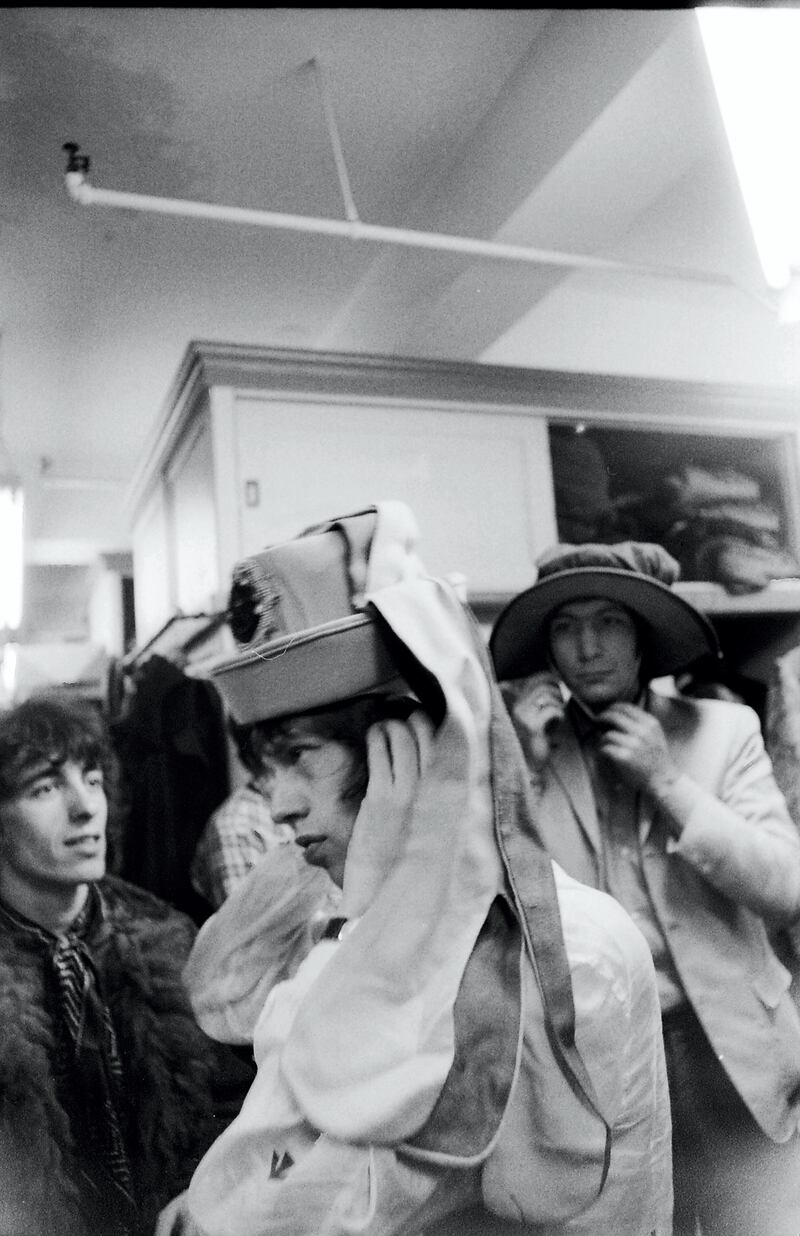John Lennon's opinion was that The Rolling Stones paid very close attention to what The Beatles were up to. Or, as he apparently once put it: "The Beatles sneeze, the Stones catch a cold."
To anyone looking today, this never seems more self-evident than when considering The Rolling Stones' second album of 1967, Their Satanic Majesties Request, a record not generally regarded as one of their best. On the cover, the group sit for Michael Cooper's camera dressed in the psychedelic finery of the time, much as The Beatles had done for their Sgt Pepper's Lonely Hearts Club Band, the defining record of the "summer of love", a few months earlier. Founder member Brian Jones wears a huge pink top hat. Guitarist Keith Richards sports a coat painted all the colours of the rainbow. Mick Jagger has come as a regal wizard, in a black cape and hat.

The Beatles LP sleeve had made reference to the Stones. The Stones’ LP now, in turn, made reference to The Beatles, their four faces appearing discreetly on the sleeve. The Beatles had come up with fun ideas for their record, such as a cardboard moustache you could cut out and, if you wished, wear. Now the Stones subsequently tried to have their own fun, an expensive “lenticular” cover which, if you held it a certain way, made it appear that the group’s members were looking at each other. This deluxe 50th anniversary edition of the album restores that cover, and presents the album in mono and in stereo, on vinyl and CD.
Released as it was in December, Satanic Majesties made The Rolling Stones – pioneers of singles Paint It Black and Satisfaction in the previous two years – now appear as if they had completely missed the boat. This vessel was bound for the communal goodwill, bright colours and expanded consciousness of what the mainstream media was calling "flower power". Compare their stony faces to the beaming foursome who grinned out from the gatefold of Sgt Pepper's, and the Stones look late for a party they were not in the mood for anyway.
In fairness, it had been a very trying year, characterised not by love but by mounting frustrations. Once a useful marketing tool, by 1967, The Rolling Stones' self-developed reputation as bad boys – "Would you let your daughter marry a Rolling Stone?" – began to make them persons of interest in a rather more serious, unhelpful fashion.
On February 12, Keith Richards' home in West Sussex was raided by police – and he and Mick Jagger were arrested. What officers found there provided daily newspapers with a wealth of titillation for their readers about the decadent lives of pop stars, and while the ensuing legal drama helped create a lot of interesting newsprint and some great art – not least Richard Hamilton's painting Swingeing London – it also helped to seriously undermine what the band were able to accomplish in the studio that year.
Things anyway were tense in the group. Their Between the Buttons LP, released in January, was far from a killer, and the band were becoming disillusioned with manager Andrew Loog Oldham, who had produced it. In January, they refused his urging to participate in the end-of-programme jollity of British prime-time show Sunday Night at the London Palladium. Brian Jones, weakened by his embrace of the rock lifestyle, was hospitalised in February after a bout of pneumonia.
In March and April, the band toured in northern Europe, but they might as well have stayed in one place: there were near-identical riots at gigs in Helsingborg, Sweden, then in Vienna, and again in Zurich. In May, they returned to London for Richards and Jagger to be formally bailed in advance of their trial – only for Brian Jones, until this point a comparatively innocent bystander, to be arrested for a different offence.
While Sgt Pepper's was enjoying its run at the top of the charts, The Rolling Stones lived a strange double life. In one, they were present at the upper tier events of the summer of love (singing backing vocals on The Beatles' All You Need Is Love, for example). In another, they languished at Her Majesty's pleasure. Now without a producer, developing their own new album was something to which they could apply less focus.
By the time the Jagger/Richards convictions were quashed on July 31, they had, however, finally found a means to take back the musical initiative. We Love You, recorded earlier that month and released in mid-August, is miraculously among the best Stones singles, in which, against a hypnotic piano riff and the sound of clanging jail doors, Jagger celebrates his victory over the establishment. "You will never win 'we'," he sings, triumphantly. "Your uniforms don't fit 'we'."
Outside the studio, things seemed to be looking up. Jagger and girlfriend his Marianne Faithfull joined The Beatles in Bangor to seek spiritual enlightenment with the Maharishi Mahesh Yogi in August, and plans were discussed for The Beatles and Stones to open a jointly owned recording studio. The celebratory mood could not, however, sustain itself into a long playing record.
Unofficial recordings pursued by collectors reveal that the band did have excellent songs in advanced stages of development. Such studio sessions, the sort of thing fans hoped might be on this release, but aren't, illustrate the how the best songs on the album (Citadel, She's a Rainbow and particularly 2000 Light Years from Home, the lyrics to which Jagger apparently wrote while held in prison overnight) find the group pushing the envelope of their rhythm and blues, embracing innovative sounds and arrangements.
With the two key songwriters potentially facing prison time, it is a miracle there are even that many highs, but three great songs can't carry an album. There is nothing explicitly wrong with the Pink Floyd-ish sound of Bill Wyman composition In Another Land, which the band even released as a single, but its writer sings it like he is an undertaker's apprentice coughing during an interment, rather than a playful ambassador of the new Aquarian Age.
A song such as Sing This All Together (See What Happens) – and its various reprises – has a strange, haunted tune, but it is a mixture of undeveloped and overlong, extended beyond its lifespan in a transparent attempt to fill space. The ghastly Gomper shows that while the Stones might have been exquisite feel players, free-form jamming couldn't conjure magic from nowhere. The Lantern, with its would-be-epic ambitions and organic instrumentation, by contrast, sounds warm and natural, a throw-forward to their recordings of 1968 and 1969, when all the present pageant would be behind them.
Around the release of We Love You in August, Jagger told a reporter that his new record was not in anyway a symptom of the Stones' part in any wider movement. "I'm not involved with all this whole 'love and flowers' scene," he said, and he was right. Psychedelia and its attendant advances in the recording studio now gave bands the opportunity to create a hermetic sound experience, but this wasn't a particularly natural way for The Rolling Stones to work.
Their best music came – indeed, still comes – on an instinctive basis, more heart than head. Their Satanic Majesties Request did a fine job of adapting to the prevailing fashions and conditions, but came out sounding strangely more like
The Rolling Stones. Theirs was the sound not of euphoria and consolation, but of a world where a cold draught sometimes leaked in. Not summer at all, but winter.
_______________
Read more:
Covers LPs seem to be more in vogue than ever
[ Rolling Stones' Ronnie Wood reveals cancer scare ]
[ Keith Richards confirms The Rolling Stones planning new album ]
_______________





